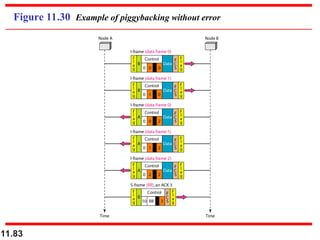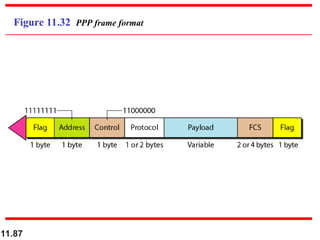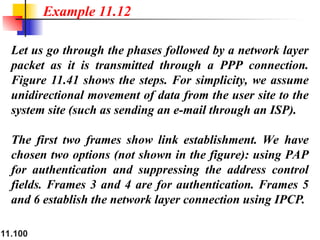DATALINK CONTROL and it's functional programming
- 1. 11.1 Chapter 11 Data Link Control Copyright © The McGraw-Hill Companies, Inc. Permission required for reproduction or display.
- 2. 11.2 11-1 FRAMING 11-1 FRAMING The data link layer needs to pack bits into The data link layer needs to pack bits into frames frames, so , so that each frame is distinguishable from another. Our that each frame is distinguishable from another. Our postal system practices a type of framing. The simple postal system practices a type of framing. The simple act of inserting a letter into an envelope separates one act of inserting a letter into an envelope separates one piece of information from another; the envelope serves piece of information from another; the envelope serves as the delimiter. as the delimiter. Fixed-Size Framing Variable-Size Framing Topics discussed in this section: Topics discussed in this section:
- 3. 11.3 Figure 11.1 A frame in a character-oriented protocol
- 4. 11.4 Figure 11.2 Byte stuffing and unstuffing
- 5. 11.5 Byte stuffing is the process of adding 1 extra byte whenever there is a flag or escape character in the text. Note
- 6. 11.6 Figure 11.3 A frame in a bit-oriented protocol
- 7. 11.7 Bit stuffing is the process of adding one extra 0 whenever five consecutive 1s follow a 0 in the data, so that the receiver does not mistake the pattern 0111110 for a flag. Note
- 8. 11.8 Figure 11.4 Bit stuffing and unstuffing
- 9. 11.9 11-2 FLOW AND ERROR CONTROL 11-2 FLOW AND ERROR CONTROL The most important responsibilities of the data link The most important responsibilities of the data link layer are layer are flow control flow control and and error control error control. Collectively, . Collectively, these functions are known as these functions are known as data link control data link control. . Flow Control Error Control Topics discussed in this section: Topics discussed in this section:
- 10. 11.10 Flow control refers to a set of procedures used to restrict the amount of data that the sender can send before waiting for acknowledgment. Note
- 11. 11.11 Error control in the data link layer is based on automatic repeat request, which is the retransmission of data. Note
- 12. 11.12 11-3 PROTOCOLS 11-3 PROTOCOLS Now let us see how the data link layer can combine Now let us see how the data link layer can combine framing, flow control, and error control to achieve the framing, flow control, and error control to achieve the delivery of data from one node to another. The delivery of data from one node to another. The protocols are normally implemented in software by protocols are normally implemented in software by using one of the common programming languages. To using one of the common programming languages. To make our discussions language-free, we have written make our discussions language-free, we have written in pseudocode a version of each protocol that in pseudocode a version of each protocol that concentrates mostly on the procedure instead of concentrates mostly on the procedure instead of delving into the details of language rules. delving into the details of language rules.
- 13. 11.13 Figure 11.5 Taxonomy of protocols discussed in this chapter
- 14. 11.14 11-4 NOISELESS CHANNELS 11-4 NOISELESS CHANNELS Let us first assume we have an ideal channel in which Let us first assume we have an ideal channel in which no frames are lost, duplicated, or corrupted. We no frames are lost, duplicated, or corrupted. We introduce two protocols for this type of channel. introduce two protocols for this type of channel. Simplest Protocol Stop-and-Wait Protocol Topics discussed in this section: Topics discussed in this section:
- 15. 11.15 Figure 11.6 The design of the simplest protocol with no flow or error control
- 16. 11.16 Algorithm 11.1 Sender-site algorithm for the simplest protocol
- 17. 11.17 Algorithm 11.2 Receiver-site algorithm for the simplest protocol
- 18. 11.18 Figure 11.7 shows an example of communication using this protocol. It is very simple. The sender sends a sequence of frames without even thinking about the receiver. To send three frames, three events occur at the sender site and three events at the receiver site. Note that the data frames are shown by tilted boxes; the height of the box defines the transmission time difference between the first bit and the last bit in the frame. Example 11.1
- 19. 11.19 Figure 11.7 Flow diagram for Example 11.1
- 20. 11.20 Figure 11.8 Design of Stop-and-Wait Protocol
- 21. 11.21 Algorithm 11.3 Sender-site algorithm for Stop-and-Wait Protocol
- 22. 11.22 Algorithm 11.4 Receiver-site algorithm for Stop-and-Wait Protocol
- 23. 11.23 Figure 11.9 shows an example of communication using this protocol. It is still very simple. The sender sends one frame and waits for feedback from the receiver. When the ACK arrives, the sender sends the next frame. Note that sending two frames in the protocol involves the sender in four events and the receiver in two events. Example 11.2
- 24. 11.24 Figure 11.9 Flow diagram for Example 11.2
- 25. 11.25 11-5 NOISY CHANNELS 11-5 NOISY CHANNELS Although the Stop-and-Wait Protocol gives us an idea Although the Stop-and-Wait Protocol gives us an idea of how to add flow control to its predecessor, noiseless of how to add flow control to its predecessor, noiseless channels are nonexistent. We discuss three protocols channels are nonexistent. We discuss three protocols in this section that use error control. in this section that use error control. Stop-and-Wait Automatic Repeat Request Go-Back-N Automatic Repeat Request Selective Repeat Automatic Repeat Request Topics discussed in this section: Topics discussed in this section:
- 26. 11.26 Error correction in Stop-and-Wait ARQ is done by keeping a copy of the sent frame and retransmitting of the frame when the timer expires. Note
- 27. 11.27 In Stop-and-Wait ARQ, we use sequence numbers to number the frames. The sequence numbers are based on modulo-2 arithmetic. Note
- 28. 11.28 In Stop-and-Wait ARQ, the acknowledgment number always announces in modulo-2 arithmetic the sequence number of the next frame expected. Note
- 29. 11.29 Figure 11.10 Design of the Stop-and-Wait ARQ Protocol
- 30. 11.30 Algorithm 11.5 Sender-site algorithm for Stop-and-Wait ARQ (continued)
- 31. 11.31 Algorithm 11.5 Sender-site algorithm for Stop-and-Wait ARQ (continued)
- 32. 11.32 Algorithm 11.6 Receiver-site algorithm for Stop-and-Wait ARQ Protocol
- 33. 11.33 Figure 11.11 shows an example of Stop-and-Wait ARQ. Frame 0 is sent and acknowledged. Frame 1 is lost and resent after the time-out. The resent frame 1 is acknowledged and the timer stops. Frame 0 is sent and acknowledged, but the acknowledgment is lost. The sender has no idea if the frame or the acknowledgment is lost, so after the time-out, it resends frame 0, which is acknowledged. Example 11.3
- 34. 11.34 Figure 11.11 Flow diagram for Example 11.3
- 35. 11.35 Assume that, in a Stop-and-Wait ARQ system, the bandwidth of the line is 1 Mbps, and 1 bit takes 20 ms to make a round trip. What is the bandwidth-delay product? If the system data frames are 1000 bits in length, what is the utilization percentage of the link? Solution The bandwidth-delay product is Example 11.4
- 36. 11.36 The system can send 20,000 bits during the time it takes for the data to go from the sender to the receiver and then back again. However, the system sends only 1000 bits. We can say that the link utilization is only 1000/20,000, or 5 percent. For this reason, for a link with a high bandwidth or long delay, the use of Stop-and-Wait ARQ wastes the capacity of the link. Example 11.4 (continued)
- 37. 11.37 What is the utilization percentage of the link in Example 11.4 if we have a protocol that can send up to 15 frames before stopping and worrying about the acknowledgments? Solution The bandwidth-delay product is still 20,000 bits. The system can send up to 15 frames or 15,000 bits during a round trip. This means the utilization is 15,000/20,000, or 75 percent. Of course, if there are damaged frames, the utilization percentage is much less because frames have to be resent. Example 11.5
- 38. 11.38 In the Go-Back-N Protocol, the sequence numbers are modulo 2m , where m is the size of the sequence number field in bits. Note
- 39. 11.39 Figure 11.12 Send window for Go-Back-N ARQ
- 40. 11.40 The send window is an abstract concept defining an imaginary box of size 2m − 1 with three variables: Sf, Sn, and Ssize. Note
- 41. 11.41 The send window can slide one or more slots when a valid acknowledgment arrives. Note
- 42. 11.42 Figure 11.13 Receive window for Go-Back-N ARQ
- 43. 11.43 The receive window is an abstract concept defining an imaginary box of size 1 with one single variable Rn. The window slides when a correct frame has arrived; sliding occurs one slot at a time. Note
- 44. 11.44 Figure 11.14 Design of Go-Back-N ARQ
- 45. 11.45 Figure 11.15 Window size for Go-Back-N ARQ
- 46. 11.46 In Go-Back-N ARQ, the size of the send window must be less than 2m ; the size of the receiver window is always 1. Note
- 47. 11.47 Algorithm 11.7 Go-Back-N sender algorithm (continued)
- 48. 11.48 Algorithm 11.7 Go-Back-N sender algorithm (continued)
- 49. 11.49 Algorithm 11.8 Go-Back-N receiver algorithm
- 50. 11.50 Example 11.6 Figure 11.16 shows an example of Go-Back-N. This is an example of a case where the forward channel is reliable, but the reverse is not. No data frames are lost, but some ACKs are delayed and one is lost. The example also shows how cumulative acknowledgments can help if acknowledgments are delayed or lost. After initialization, there are seven sender events. Request events are triggered by data from the network layer; arrival events are triggered by acknowledgments from the physical layer. There is no time-out event here because all outstanding frames are acknowledged before the timer expires. Note that although ACK 2 is lost, ACK 3 serves as both ACK 2 and ACK 3.
- 51. 11.51 Figure 11.16 Flow diagram for Example 11.6
- 52. 11.52 Figure 11.17 shows what happens when a frame is lost. Frames 0, 1, 2, and 3 are sent. However, frame 1 is lost. The receiver receives frames 2 and 3, but they are discarded because they are received out of order. The sender receives no acknowledgment about frames 1, 2, or 3. Its timer finally expires. The sender sends all outstanding frames (1, 2, and 3) because it does not know what is wrong. Note that the resending of frames 1, 2, and 3 is the response to one single event. When the sender is responding to this event, it cannot accept the triggering of other events. This means that when ACK 2 arrives, the sender is still busy with sending frame 3. Example 11.7
- 53. 11.53 The physical layer must wait until this event is completed and the data link layer goes back to its sleeping state. We have shown a vertical line to indicate the delay. It is the same story with ACK 3; but when ACK 3 arrives, the sender is busy responding to ACK 2. It happens again when ACK 4 arrives. Note that before the second timer expires, all outstanding frames have been sent and the timer is stopped. Example 11.7 (continued)
- 54. 11.54 Figure 11.17 Flow diagram for Example 11.7
- 55. 11.55 Stop-and-Wait ARQ is a special case of Go-Back-N ARQ in which the size of the send window is 1. Note
- 56. 11.56 Figure 11.18 Send window for Selective Repeat ARQ
- 57. 11.57 Figure 11.19 Receive window for Selective Repeat ARQ
- 58. 11.58 Figure 11.20 Design of Selective Repeat ARQ
- 59. 11.59 Figure 11.21 Selective Repeat ARQ, window size
- 60. 11.60 In Selective Repeat ARQ, the size of the sender and receiver window must be at most one-half of 2m . Note
- 61. 11.61 Algorithm 11.9 Sender-site Selective Repeat algorithm (continued)
- 62. 11.62 Algorithm 11.9 Sender-site Selective Repeat algorithm (continued) (continued)
- 63. 11.63 Algorithm 11.9 Sender-site Selective Repeat algorithm (continued)
- 64. 11.64 Algorithm 11.10 Receiver-site Selective Repeat algorithm
- 65. 11.65 Algorithm 11.10 Receiver-site Selective Repeat algorithm
- 66. 11.66 Figure 11.22 Delivery of data in Selective Repeat ARQ
- 67. 11.67 This example is similar to Example 11.3 in which frame 1 is lost. We show how Selective Repeat behaves in this case. Figure 11.23 shows the situation. One main difference is the number of timers. Here, each frame sent or resent needs a timer, which means that the timers need to be numbered (0, 1, 2, and 3). The timer for frame 0 starts at the first request, but stops when the ACK for this frame arrives. The timer for frame 1 starts at the second request, restarts when a NAK arrives, and finally stops when the last ACK arrives. The other two timers start when the corresponding frames are sent and stop at the last arrival event. Example 11.8
- 68. 11.68 At the receiver site we need to distinguish between the acceptance of a frame and its delivery to the network layer. At the second arrival, frame 2 arrives and is stored and marked, but it cannot be delivered because frame 1 is missing. At the next arrival, frame 3 arrives and is marked and stored, but still none of the frames can be delivered. Only at the last arrival, when finally a copy of frame 1 arrives, can frames 1, 2, and 3 be delivered to the network layer. There are two conditions for the delivery of frames to the network layer: First, a set of consecutive frames must have arrived. Second, the set starts from the beginning of the window. Example 11.8 (continued)
- 69. 11.69 Another important point is that a NAK is sent after the second arrival, but not after the third, although both situations look the same. The reason is that the protocol does not want to crowd the network with unnecessary NAKs and unnecessary resent frames. The second NAK would still be NAK1 to inform the sender to resend frame 1 again; this has already been done. The first NAK sent is remembered (using the nakSent variable) and is not sent again until the frame slides. A NAK is sent once for each window position and defines the first slot in the window. Example 11.8 (continued)
- 70. 11.70 The next point is about the ACKs. Notice that only two ACKs are sent here. The first one acknowledges only the first frame; the second one acknowledges three frames. In Selective Repeat, ACKs are sent when data are delivered to the network layer. If the data belonging to n frames are delivered in one shot, only one ACK is sent for all of them. Example 11.8 (continued)
- 71. 11.71 Figure 11.23 Flow diagram for Example 11.8
- 72. 11.72 Figure 11.24 Design of piggybacking in Go-Back-N ARQ
- 73. 11.73 11-6 HDLC 11-6 HDLC High-level Data Link Control (HDLC) High-level Data Link Control (HDLC) is a is a bit-oriented bit-oriented protocol for communication over point-to-point and protocol for communication over point-to-point and multipoint links. It implements the ARQ mechanisms multipoint links. It implements the ARQ mechanisms we discussed in this chapter. we discussed in this chapter. Configurations and Transfer Modes Frames Control Field Topics discussed in this section: Topics discussed in this section:
- 74. 11.74 Figure 11.25 Normal response mode
- 75. 11.75 Figure 11.26 Asynchronous balanced mode
- 76. 11.76 Figure 11.27 HDLC frames
- 77. 11.77 Figure 11.28 Control field format for the different frame types
- 78. 11.78 Table 11.1 U-frame control command and response
- 79. 11.79 Figure 11.29 shows how U-frames can be used for connection establishment and connection release. Node A asks for a connection with a set asynchronous balanced mode (SABM) frame; node B gives a positive response with an unnumbered acknowledgment (UA) frame. After these two exchanges, data can be transferred between the two nodes (not shown in the figure). After data transfer, node A sends a DISC (disconnect) frame to release the connection; it is confirmed by node B responding with a UA (unnumbered acknowledgment). Example 11.9
- 80. 11.80 Figure 11.29 Example of connection and disconnection
- 81. 11.81 Figure 11.30 shows an exchange using piggybacking. Node A begins the exchange of information with an I-frame numbered 0 followed by another I-frame numbered 1. Node B piggybacks its acknowledgment of both frames onto an I-frame of its own. Node B’s first I-frame is also numbered 0 [N(S) field] and contains a 2 in its N(R) field, acknowledging the receipt of A’s frames 1 and 0 and indicating that it expects frame 2 to arrive next. Node B transmits its second and third I-frames (numbered 1 and 2) before accepting further frames from node A. Example 11.10
- 82. 11.82 Its N(R) information, therefore, has not changed: B frames 1 and 2 indicate that node B is still expecting A’s frame 2 to arrive next. Node A has sent all its data. Therefore, it cannot piggyback an acknowledgment onto an I-frame and sends an S-frame instead. The RR code indicates that A is still ready to receive. The number 3 in the N(R) field tells B that frames 0, 1, and 2 have all been accepted and that A is now expecting frame number 3. Example 11.10 (continued)
- 83. 11.83 Figure 11.30 Example of piggybacking without error
- 84. 11.84 Figure 11.31 shows an exchange in which a frame is lost. Node B sends three data frames (0, 1, and 2), but frame 1 is lost. When node A receives frame 2, it discards it and sends a REJ frame for frame 1. Note that the protocol being used is Go-Back-N with the special use of an REJ frame as a NAK frame. The NAK frame does two things here: It confirms the receipt of frame 0 and declares that frame 1 and any following frames must be resent. Node B, after receiving the REJ frame, resends frames 1 and 2. Node A acknowledges the receipt by sending an RR frame (ACK) with acknowledgment number 3. Example 11.11
- 85. 11.85 Figure 11.31 Example of piggybacking with error
- 86. 11.86 11-7 POINT-TO-POINT PROTOCOL 11-7 POINT-TO-POINT PROTOCOL Although HDLC is a general protocol that can be used Although HDLC is a general protocol that can be used for both point-to-point and multipoint configurations, for both point-to-point and multipoint configurations, one of the most common protocols for point-to-point one of the most common protocols for point-to-point access is the access is the Point-to-Point Protocol (PPP). Point-to-Point Protocol (PPP). PPP is a PPP is a byte-oriented byte-oriented protocol. protocol. Framing Transition Phases Multiplexing Multilink PPP Topics discussed in this section: Topics discussed in this section:
- 87. 11.87 Figure 11.32 PPP frame format
- 88. 11.88 PPP is a byte-oriented protocol using byte stuffing with the escape byte 01111101. Note
- 89. 11.89 Figure 11.33 Transition phases
- 90. 11.90 Figure 11.34 Multiplexing in PPP
- 91. 11.91 Figure 11.35 LCP packet encapsulated in a frame
- 92. 11.92 Table 11.2 LCP packets
- 93. 11.93 Table 11.3 Common options
- 94. 11.94 Figure 11.36 PAP packets encapsulated in a PPP frame
- 95. 11.95 Figure 11.37 CHAP packets encapsulated in a PPP frame
- 96. 11.96 Figure 11.38 IPCP packet encapsulated in PPP frame
- 97. 11.97 Table 11.4 Code value for IPCP packets
- 98. 11.98 Figure 11.39 IP datagram encapsulated in a PPP frame
- 99. 11.99 Figure 11.40 Multilink PPP
- 100. 11.100 Let us go through the phases followed by a network layer packet as it is transmitted through a PPP connection. Figure 11.41 shows the steps. For simplicity, we assume unidirectional movement of data from the user site to the system site (such as sending an e-mail through an ISP). The first two frames show link establishment. We have chosen two options (not shown in the figure): using PAP for authentication and suppressing the address control fields. Frames 3 and 4 are for authentication. Frames 5 and 6 establish the network layer connection using IPCP. Example 11.12
- 101. 11.101 The next several frames show that some IP packets are encapsulated in the PPP frame. The system (receiver) may have been running several network layer protocols, but it knows that the incoming data must be delivered to the IP protocol because the NCP protocol used before the data transfer was IPCP. After data transfer, the user then terminates the data link connection, which is acknowledged by the system. Of course the user or the system could have chosen to terminate the network layer IPCP and keep the data link layer running if it wanted to run another NCP protocol. Example 11.12 (continued)
- 102. 11.102 Figure 11.41 An example
- 103. 11.103 Figure 11.41 An example (continued)
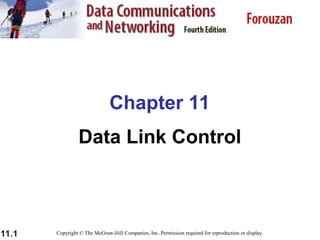

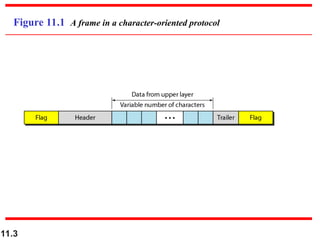

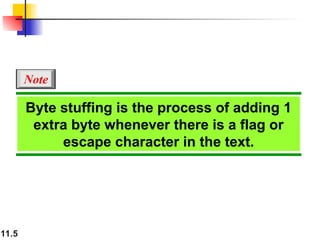


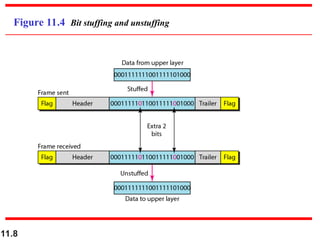
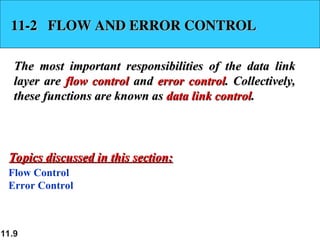

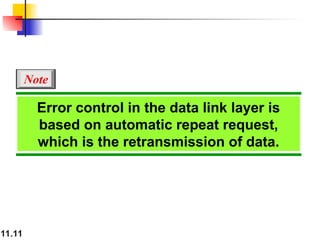





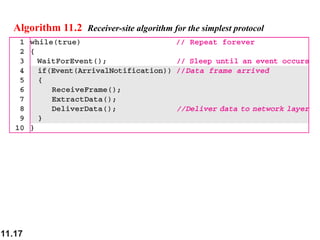






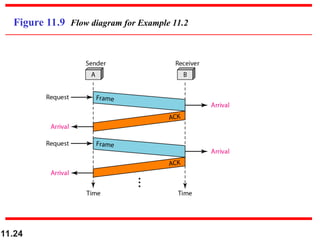







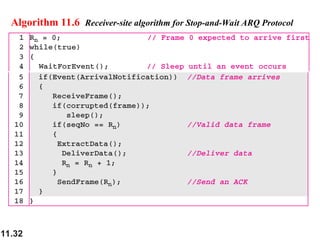








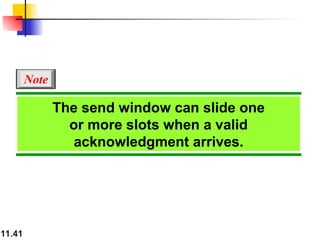















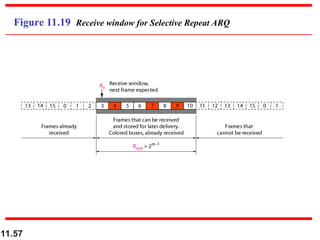









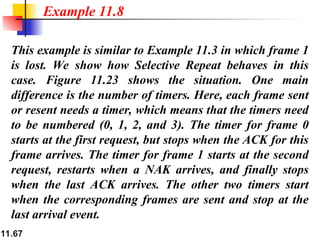

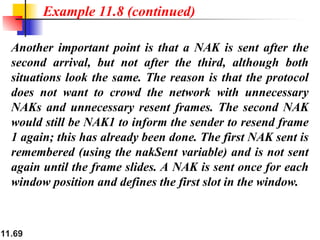
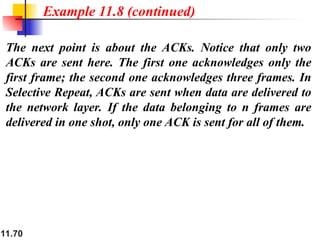










![11.81
Figure 11.30 shows an exchange using piggybacking.
Node A begins the exchange of information with an
I-frame numbered 0 followed by another I-frame
numbered 1. Node B piggybacks its acknowledgment of
both frames onto an I-frame of its own. Node B’s first
I-frame is also numbered 0 [N(S) field] and contains a 2
in its N(R) field, acknowledging the receipt of A’s frames
1 and 0 and indicating that it expects frame 2 to arrive
next. Node B transmits its second and third I-frames
(numbered 1 and 2) before accepting further frames from
node A.
Example 11.10](https://image.slidesharecdn.com/1datalinkcontrol-250710134743-e06a32b2/85/DATALINK-CONTROL-and-it-s-functional-programming-81-320.jpg)

